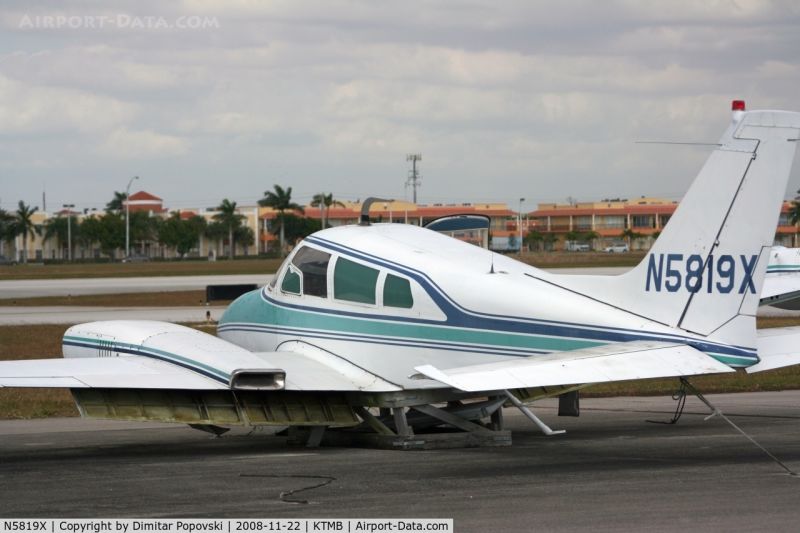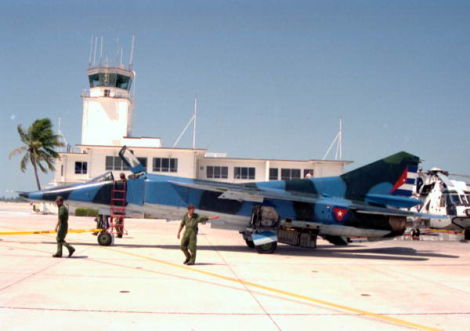
NAS Key West, FL, 10 March 1991
Development work on the MiG-23 began in 1965 with the purpose of replacing earlier MiG-15, -17, -19 and -21 fighters in Soviet service and with Warsaw Pact and export clients. The new aircraft was to have better range and performance than the MiG-21, as well as more capable avionics and beyond visible range (BVR) missiles. Another requirement would be a shorter take-off run than the earlier MiGs, and two potential technologies were investigated. One prototype, 23-01, was fitted with lift jets, hence the designation MiG-23PD, Podyomnye Dvigatyeli – literally “lift jet”.
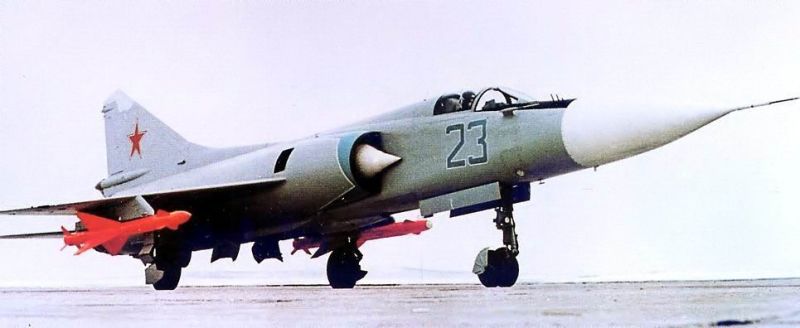
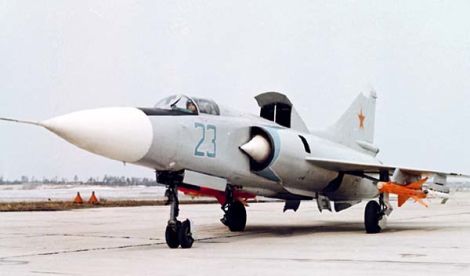
23-01 quickly proved that the lift jets worked, but that they were dead weight after take-off, and the idea was abandoned. Proceeding in parallel, a second team was working on prototype 23-11, which incorporated variable geometry wings, which TsAGI had been researching since capturing German documents and scientists after WWII. The 23-11's wings could be set to angles of 16°, 45° and 72°. The swing-wing prototype showed its clear superiority over the 23-01, and a production derivative was ordered in 1967.
The MiG-23 was quickly accepted by the Soviet Air Forces, but widespread acceptance by Warsaw Pact forces was not forthcoming. The MiG proved to be more of an interceptor than a dog-fighter, and was more expensive to operate than the MiG-21 it was supposed to replace. Down-rated variants of the type were widely exported to Middle Eastern countries looking to replace less-capable 1st and 2nd generation fighters, as well as ground-attack versions that had been developed in the interim.
One of the few nations outside Europe and the Middle East to receive the MiG-23 was Cuba, which received a number of fighter and fighter-bomber aircraft.
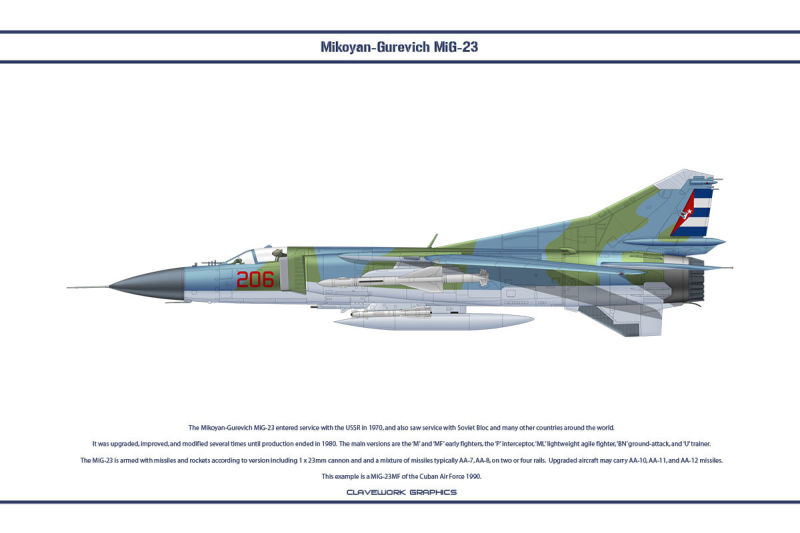
A pilot of one of those Cuban MiGs was Orestes Lorenzo Pérez, formerly a major in the Defensa Anti-Aérea Y Fuerza Aérea Revolucionaria. As a young boy in pre-Castro Cuba, Orestes received a toy plane from an uncle living in Florida, igniting a life-long love of flying. After the Revolution, he was sent to the Soviet Union for flight training, logging approximately 130 hours in L-29 Aero L-29 Delfín trainers, and another 130 hours in MiG-21s.
“My class was 3 months in ground school which took place in the spring. Instructional materials were plentiful and good. Flying began in the summer.
Typical flying was initially patterns around the local region. We then learned to fly formation and afterward aerobatics. If the training lacked anything it was flying to different airfields. We always took off from and returned to the same airfield.”
Despite (or perhaps because of) his time in the USSR, Orestes found himself becoming disillusioned with the promise of Castro’s Revolucion:
“The socialist system never worked, despite the fact that to the masses socialism was touted as the best form of government. The standard of living was incredibly poor. Sanitary and living conditions for ordinary citizens were atrocious. Alcoholism and adultery were epidemic, and racism was systemic.”
Time spent with the Fuerzas Armadas Revolucionarias in Angola further deepened his discontent, and after being sent back to the USSR to attend the Marshall Gregory Zhukov War College he began to hatch a plan to leave Cuba. In 1991 Orestes was tapped for training in the MiG-23, and he knew it was time to act. On March 20th he was to have his first solo flight, and Orestes put his plan into motion. After taking off in a MiG-23BN, registration number 722, the major turned north and dropped down to wave-top heights.
Orestes soon arrived over NAS Key West, but he faced a problem. Unable to communicate with American radios as his own was preset to Cuban frequencies, he entered the pattern to land, then made several passes over the base, his landing gear and flaps lowered and his air brakes and wings extended, as he waggled his wings hoping to convince the Americans of his intentions.
After completing his landing, Orestes waited, his engine idling, for the Americans to make the next move. Eventually a truck came out to meet him, and guided the Cuban aircraft to a ramp. Orestes cut his engine and jumped out as another car appeared, this time carrying a naval officer and an enlisted man to translate.
Orestes explained who he was, and that he was requesting asylum. After the younger man translated for the officer, who was in fact the base commander, Orestes was welcomed with a handshake.
Within a few days, a pilot with the FAR, along with a high-ranking DGI agent, were sent to retrieve the MiG-23, which was inspected at NAS Key West, then flown out.
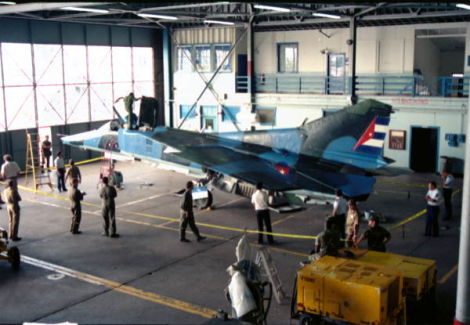
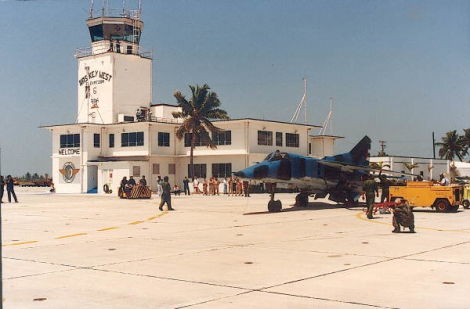
The story doesn’t end there though. After settling in Alexandria, Orestes began to work to retrieve his wife and sons, left behind in Cuba. Along with family in the United States, he spoke out about conditions in Cuba, gaining support amongst American politicians and activists, with President HW Bush and Coretta Scott King both attempting to pressure Castro into releasing the Perez family.
Growing impatient with the Cuban leader’s intransigence, Orestes again took matters into his own hands, and began to plan for a return trip to the island of his birth, this time to rescue his family. A supporter funded his purchase of a Cessna 310F, and using his knowledge of Cuban air defenses, radar and tactics, planned his route in, as well as a place to land. He was able to get messages to his wife via friends and family both in the US and in Cuba, and on 18 December 1992 all the pieces were in place. The following day, Orestes took off and headed for Cuba, almost retracing his route from the year before. Eventually he landed on a coastal road near Varadero, and picked up his wife and children. A tense but uneventful flight back to the States followed, and the Perez family landed at Marathon, now free from Cuba.
Orestes sold the 310, though he tried to buy it back, only to be told it had been written off after damage from a hurricane. The MiG-23 he’d flown to Key West all those years ago had also been scrapped, with bits being sold to tourists.

